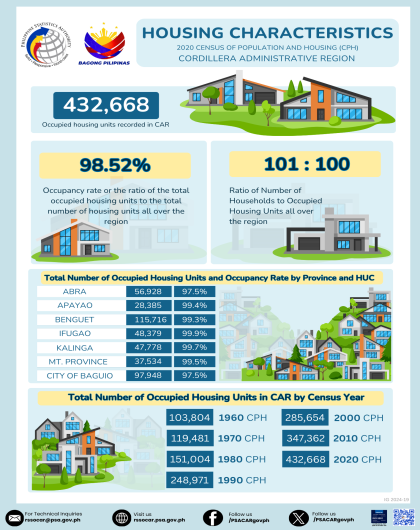Based on the 2020 Census of Population and Housing (2020 CPH), the Cordillera Administrative Region (CAR) had a total population of 1,797,660 individuals. Out of this total, the household population comprised 99.6 percent or 1,791,121 individuals. This was higher by 4.5 percent from the 1,714,220 household population in 2015.
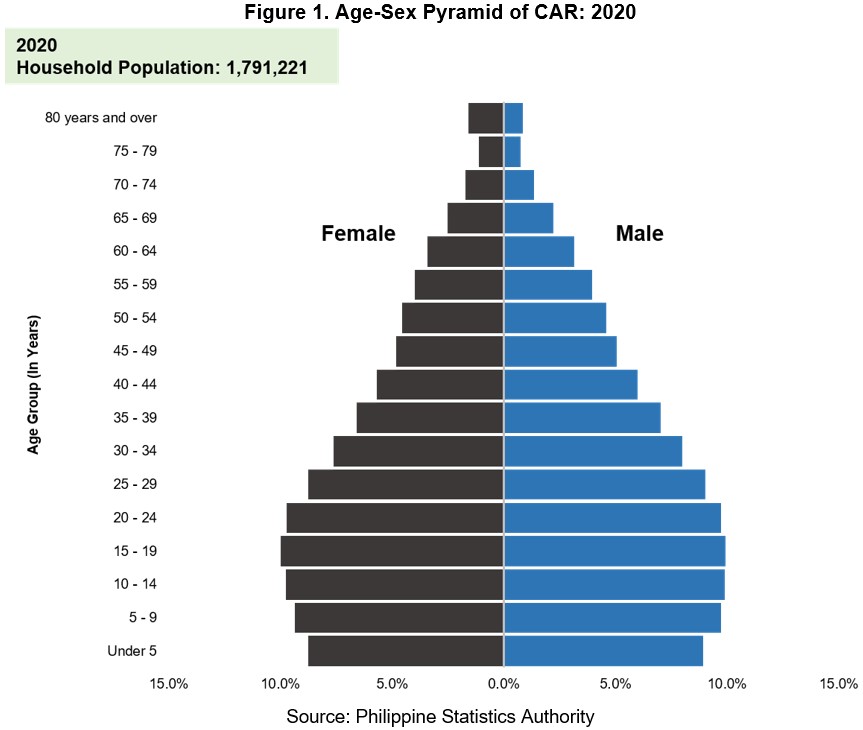
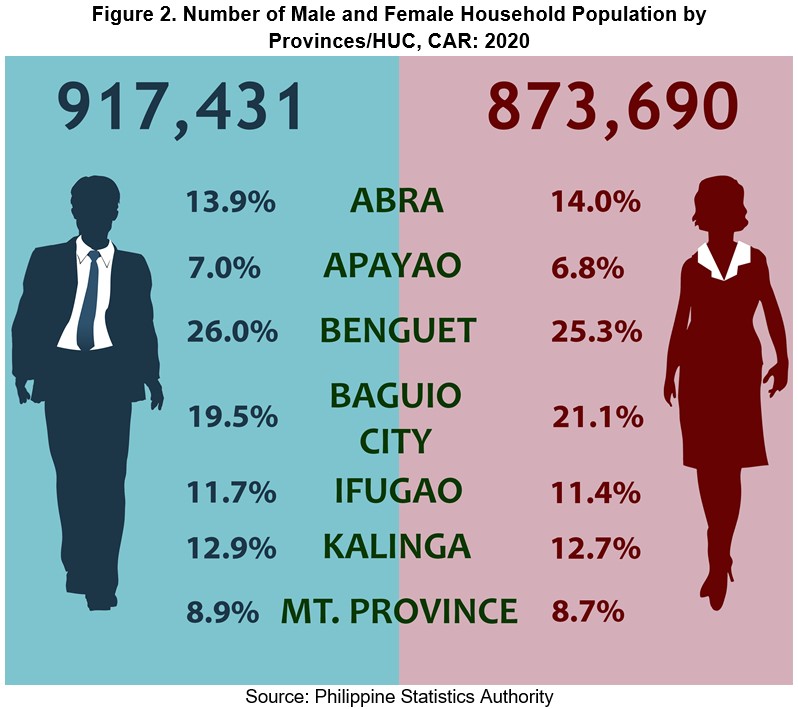
Of the 1.8 million household population of CAR in 2020, 51.2 percent or 917,431 were males while 48.8 percent or 873,690 were females. Benguet, which posted the highest total population among the provinces/city in the Cordillera region, comprised 26.0 percent of the total male household population and 25.3 percent for female population. Baguio City, the only Highly Urbanized City (HUC) and also the second province/city with highest population in the region, recorded the second province/HUC with highest number of male and female household population in the region with 19.5 percent and 21.1 percent, respectively.
Dependents comprise one-third of household population
In 2020, there were 612,977 dependents recorded in the Cordillera region. This number covered 34.2 percent of the total household population that depends on the remaining 65.8 percent or the working age group (15-64 years old). Dependent population comprised of 28.2 percent or 505,157 young dependents (under 15 years old) and 6.0 percent or 107,820 old dependents (65 years old and over) to the total household population in the region.
For young dependents, there were more males than females with 261,768 individuals and 243,389 individuals, respectively. Meanwhile, there were more female than male old dependents in the region with 60,797 female old dependents and 47,023 male old dependents in 2020.
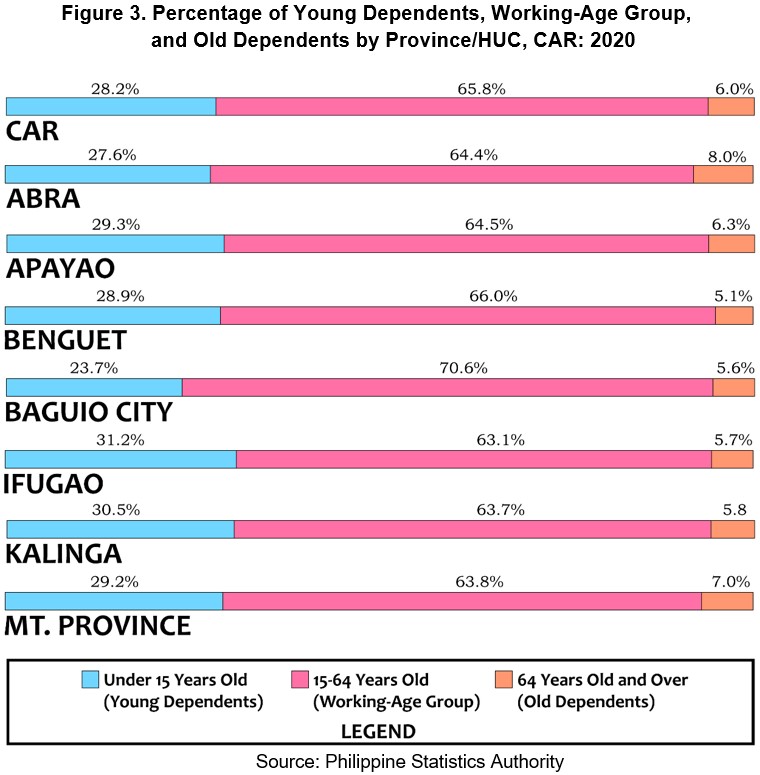
Among the provinces/HUC in CAR, Ifugao had the highest percentage of young dependents in 2020 with 31.2 percent. This was followed by Kalinga and Abra with 30.5 percent and 29.3 percent, respectively.
For old dependents, the highest percentage was in Abra with 8.0 percent. This was followed by Mt. Province with 7.0 percent and Apayao with 6.3 percent. Benguet recorded the least percentage of old dependents with 5.1 percent.
Conversely, Baguio City had the highest percentage of working-age groups with 70.6 percent of its household population or 256,566 individuals. This was followed by Benguet with 66.0 percent or 303,077 out of 459,468 household population in the province.
Females outnumber males in older age group
The Cordillera region recorded 1,553,368 individuals who were under 55 years old (younger age group). This contributed 1.6 percent to the total number of younger age groups in the Philippines. There were more males (805,278 individuals or 51.8 percent) than females (748,090 individuals or 48.2 percent) under this age group in 2020. In addition, the number of young male individuals increased by 2.9 percent in 2020 from 782,287 young male individuals recorded in the region in 2015. Similarly, the young female individuals increased by 1.5 percent from the recorded 737,104 young female individuals in 2015.
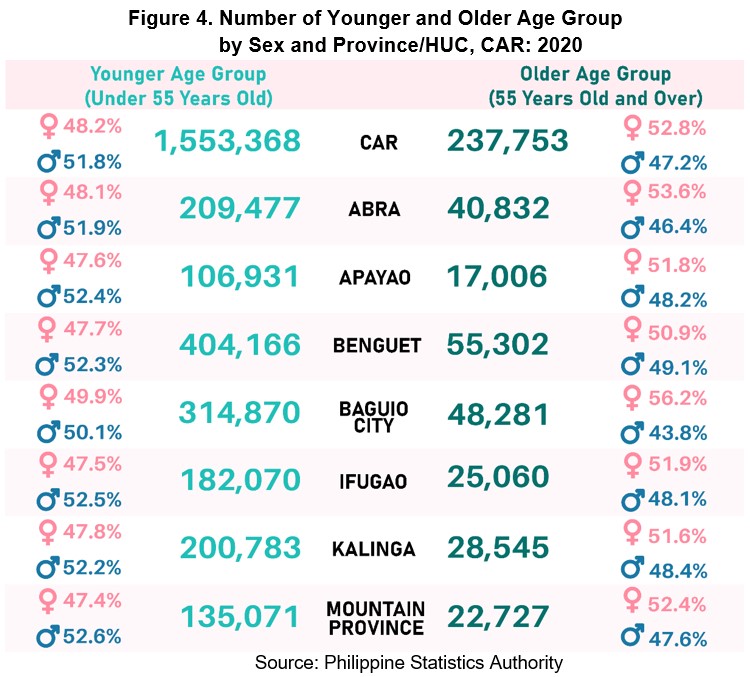
Meanwhile, there were 237,753 individuals under the older age group (55 years old and over) in 2020. This was a 22.0 percent increase from the 194,829 older individuals recorded in 2015. In addition, there were more females under the older age group with 125,600 individuals or a share of 52.8 percent compared to males with 112,153 individuals or 47.2 percent share.
Among the provinces/HUC, Benguet registered the highest number of younger age groups with 404,166 individuals or 88.0 percent of its household population. The young age group comprised 47.7 percent young female individuals and 52.3 percent young male individuals.
Ifugao recorded the second highest number of younger age groups with 87.9 percent of its household population or 182,070 individuals. This was followed by Kalinga with 87.6 percent or 200,783 individuals.
Furthermore, Abra registered the highest number of older age groups with 40,832 individuals. This was 16.3 percent of the 250,309 household population in their province. Moreover, 53.6 percent of the older age group were females and 46.4 percent were males.
Mt. Province recorded the second highest number of older age groups with 14.4 percent of its household population or 22,727 individuals. This was followed by Apayao with 13.7 percent or 17,006 individuals.
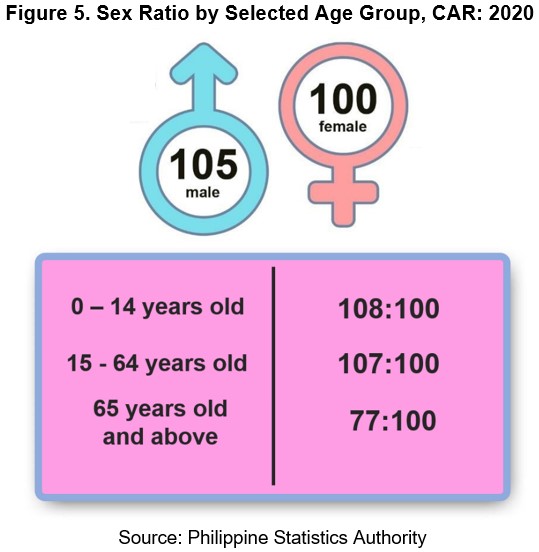
Males outnumber females in Cordillera region
The sex ratio in CAR was computed at 105:100 in 2020. This means that there were 105 males for every 100 females in the region. The sex ratio in 2015 was slightly lower at 104 males per 100 females.
In 2020, children aged below 15 years had sex ratio of 108 males per 100 females, while individuals who were 15 to 64 years old had sex ratio of 107 males per 100 females. In addition, individuals who were 65 years and over had sex ratio of 77 males per 100 females. This implies a higher mortality rate among males than females in the old age groups. In other words, females have a longer life expectancy than males.
Median age increases to 26.2 years
The median age of the population in the Cordillera region was computed at 26.2 years. Meaning, half of the household population was younger than 26.2 years while the other half is older than 26.2 years. This was also higher than the median age recorded in 2015 with median age of 24.1 years.
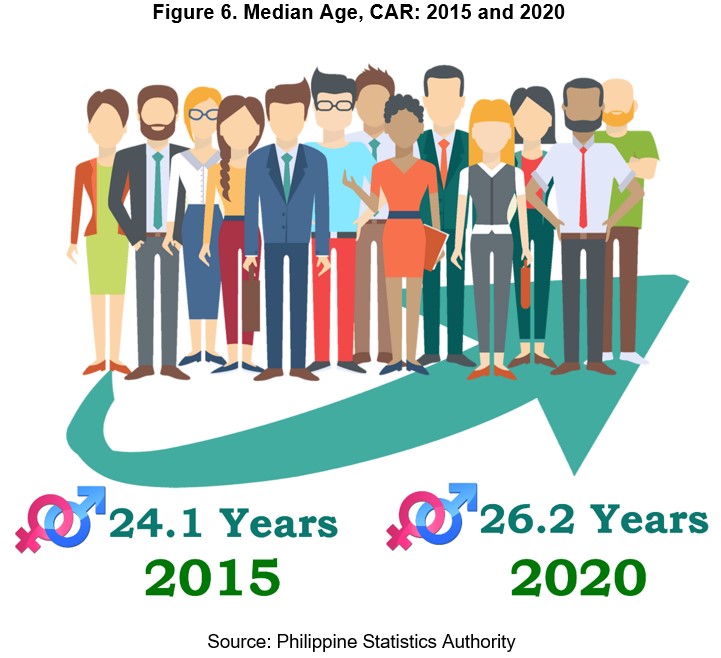
VILLAFE P. ALIBUYOG
Regional Director
___________________________________________
TECHNICAL NOTES
The Philippine Statistics Authority conducted the 2020 Census of Population and Housing (2020 CPH) in September 2020, with 01 May 2020 as reference date.
The 2020 CPH was the 15th census of population and 7th census of housing that was undertaken in the Philippines since the first census in 1903. It was designed to take inventory of the total population and housing units in the country and collect information about their characteristics.
The Philippine Standard Geographic Codes as of April 2022 was used for the disaggregation of geographic levels of the 2020 CPH.
Household is a social unit consisting of person or a group of persons who sleep in the same housing unit and have a common arrangement in the preparation and consumption of food.
Household population refers to all persons who are members of the household.
Sex is the biological and physiological reality of being a male or female.
Age refers to the interval of time between the person’s date of birth and his/her last birthday prior to the census reference date. It is expressed in completed years or whole numbers.
Age-sex structure is the composition of a population as determined by the number of or proportion of males and females in each age category. The age-sex structure of a population is the cumulative result of past trends in fertility, mortality, and migration. Information on age-sex composition is essential for the description and analysis of many other types of demographic data.
Population pyramid is a bar chart, arranged vertically, that shows the distribution of a population by age and sex. By convention, the younger ages are at the bottom, with males on the left and females on the right.
Sex ratio is the number of males per one hundred females in a population.
Median age is the age that divides the population into two numerically equal groups; that is, half of the population are younger than this age and the other half are older.
Overall dependency ratio is the number of persons under 15 years old (young dependents) and persons aged 65 and older (old dependents) per one hundred persons 15 to 64 years old (working-age or economically-productive group) in a population.
Aging of population is a process in which the proportions of adults and elderly increase in a population, while the proportions of children and adolescents decrease. This process results in a rise in the median age of the population. Aging occurs when fertility rates decline while life expectancy remains constant or improves at the older ages.
Aging index is calculated as the number of persons 60 years old and over per one hundred persons under the age of 15 years.


